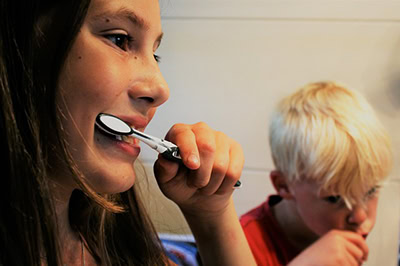Periodontitis
Early signs of infection
| Download this episode | When you brushed your teeth and flossed this morning, did you notice that your gums were bleeding? If you did, you may be one of millions of Americans who are suffering from periodontal disease, or gum disease. Swollen and bleeding gums are early signs that your gums are infected with bacteria. If nothing is done, the infection can spread. “Peri” means around, and “odontal” refers to teeth. Periodontal diseases are infections of the structures around the teeth. These include the gums, the cementum that covers the root, the periodontal ligament and the alveolar bone. Periodontal disease can range from simple gum inflammation to severe forms of the disease that result in major damage to the soft tissue and bone that support the teeth. In the worst cases, teeth are lost. Whether your gum disease is stopped, slowed, or gets worse depends a great deal on how well you care for your teeth and gums every day, from this point forward. | Gingivitis is a common and mild form of gum disease that causes irritation, redness and swelling of your gums. The most common cause of gingivitis is poor oral hygiene that encourages plaque to form. Plaque is an invisible, sticky film composed mainly of bacteria. Plaque forms on your teeth when starches and sugars in food interact with bacteria normally found in your mouth. Plaque that stays on your teeth longer than two or three days can harden under your gumline into tartar. Tartar makes plaque more difficult to remove and creates a protective shield for bacteria. The longer that plaque and tartar remain on your teeth, the more they irritate the gingiva, the part of your gum around the base of your teeth. In time, your gums become swollen and bleed easily. Gingivitis usually clears up after a thorough professional cleaning, as long as you continue good oral hygiene at home. So be sure to talk to your dentist about an effective at-home program. | Plaque is the main cause of gum disease, but certain factors can increase your risk for the disease. One of the most significant risk factors associated with the development of gum disease is tobacco. Some drugs, such as oral contraceptives and certain heart medicines, can affect a person’s oral health. Just as you notify your pharmacist and other health care providers of all medicines you are taking and any changes in your overall health, you should also inform your dental care provider. Clenching or grinding your teeth can put excess force on the supporting tissues of the teeth and could speed up the rate at which these periodontal tissues are destroyed. Research has shown that some people may be genetically susceptible to gum disease. Identifying these people with a genetic test before they even show signs of the disease and getting them into early intervention treatment may help them keep their teeth for a lifetime. | Periodontitis is a serious form of gum disease that damages the soft tissue and destroys the bone that supports your teeth. It can cause tooth loss and other serious health problems. Periodontitis occurs when inflammation or infection of the gums is allowed to progress without treatment. Infection and inflammation spreads from the gums to the ligaments and bone that support the teeth. Loss of support causes the teeth to become loose and eventually fall out. Ongoing inflammation eventually causes pockets to develop between your gums and teeth that fill with plaque, tartar and bacteria. Bacteria deposit endotoxin, a byproduct of their own metabolism, which is responsible for much of the inflammation around teeth. In time, these pockets become deeper and more bacteria accumulate, eventually advancing under your gum tissue. These deep infections cause a loss of tissue and bone. If too much bone is destroyed, you may lose one or more teeth. | Treating periodontitis, the most severe form of gum disease, involves thoroughly cleaning the pockets around infected teeth and preventing damage to the surrounding bone. Mild periodontitis is usually treated with a cleaning called scaling and root planing. Scaling removes plaque and tartar from your teeth. Scaling cleans the teeth above and below the gum line. Root planing smooths the roots, making it harder for bacteria to stick there and grow. Combined with at-home brushing and flossing, this special cleaning often is enough to cure periodontitis. Severe periodontitis usually requires surgery as well as a round of oral antibiotics. Treatment may also include removal of teeth that can’t be saved. The best way to prevent periodontitis is to follow a program of good oral hygiene that includes brushing your teeth at least twice daily and flossing at least once. And be sure to see a dentist or dental hygienist regularly for cleanings, at least once every six months.
Transcript
An invisible sticky film
Transcript
Significant risk factors
Transcript
A loss of tissue and bone
Transcript
Good oral hygiene
Transcript
